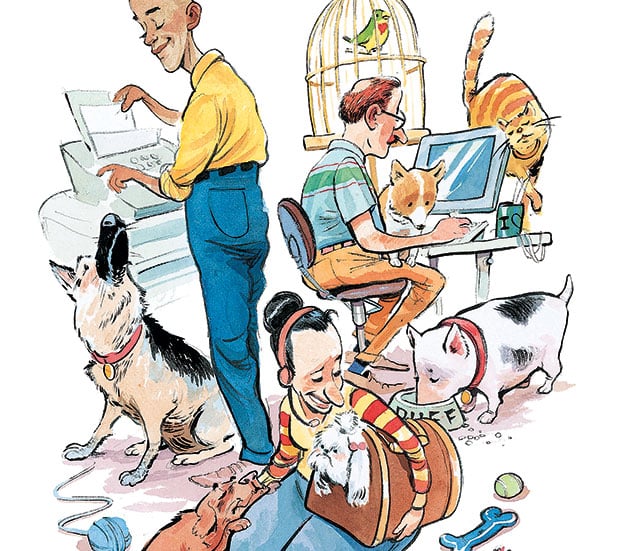At MGAC, a construction-management firm, the rules are simple: no growling, no biting, no excessive barking. Petting, nuzzling, and fetching, on the other hand, are encouraged.
Most days, only humans occupy the company’s contemporary offices across the street from the Grand Hyatt in downtown DC. On Fridays, though, their dogs can join them.
Controller Elaine Maddalena owns Oscar, a beagle, as well as Gordon and Cosmo, German short-haired pointers. The three take turns visiting on Fridays, loping from desk to desk to greet familiar faces but mostly lounging at Maddalena’s side. “Everyone seems happy to have them around,” she says. “And the dogs love the attention.”
In response to employee requests, human-resources director Mollie O’Donnell devised Dog Fridays two years ago. The idea was to increase employee happiness and encourage positive work relationships and team building. The theory is that dogs make workplaces feel friendlier and less hierarchical—if your boss offers to walk your dog, it can soften the impact when he or she tells you to finish a report by the end of the day. “They bring a really nice change of atmosphere,” says CFO Matthew Anderson, owner of Gizmo, a Pembroke Welsh corgi. “If you have a meeting and you know it’s going to be tense, you can just bring him in and it changes the dynamic.”
The soft and fuzzy benefits of workplace pets are borne out by numbers. In 2005, researchers from the Center for Human-Animal Interaction at Virginia Commonwealth University found—using blood and saliva samples—that therapy-dog sessions reduced levels of stress-related hormones in health-care workers. In 2012, they followed up by studying self-reported stress levels in office workers. In employees who didn’t bring dogs to work, stress rose throughout the workday. In those who did bring dogs, stress dropped as the day went on.
Still, only 5 percent of US companies allow pets, according to the Society for Human Resource Management. Lisa Orndorff, who heads employee relations and engagement there, says workplace pets aren’t always a good fit. Companies have to account for allergies or phobias, and in industries such as food service and manufacturing, the presence of pets would be neither safe nor practical.
Orndorff says companies that decide to allow pets need to establish rules about animal behavior and hygiene and make sure animals are up to date on immunizations. Also, though owners are generally responsible for damage or injury caused by their pets, companies should consult with legal counsel to clarify potential liability.
At Anthony Wilder Design/Build, an architecture firm in Cabin John, owners and employees embrace the pet-friendly ethos. The renovated red-brick firehouse is specially equipped to cater to canines: Cubicles are fitted with baby gates to keep dogs in place, file cabinets are filled with dog chow, and there’s a cleanup-bag dispenser outside. “We know they bring us joy and happiness and help us be more productive at work, so we make accommodations for them,” says Elizabeth Wilder. She and husband Anthony co-own the company and always bring their two rottweiler mixes, Tank and Izzy, to work.
Dogs are allowed every day, and most days there are four or five. Some employees like to take their dogs running on the nearby C&O Canal towpath during breaks. Others enjoy strolling around the neighborhood. Marketing director Danielle Frye has been bringing Lily, a rottweiler/German-shepherd mix, almost every day since she got her as a puppy four years ago. “If you’re having a stressful moment,” she says, “it’s really nice to hang out with a dog.”
This article appears in the June 2014 issue of Washingtonian.


















